Climate Emergency: Construction Industry's Mitigation Effects
VerifiedAdded on 2022/12/29
|52
|18065
|1
Report
AI Summary
This report critically examines the construction industry's role in mitigating the effects of climate change. It begins by defining climate change and its broad impact on construction projects, including economic and environmental systems, and interactions between land degradation, forests, and water points. The report outlines the research aim to investigate how the construction industry can mitigate climate change, and sets objectives to study the impact of climate change on buildings, assess ways to reduce the industry's contribution, identify strategies to reduce the costs of 'going green,' and evaluate the use of renewable materials. The literature review covers the impact of climate change on buildings, ways to reduce the industry's contribution, strategies for cost reduction, and the role of renewable materials. The report includes a discussion on research methodology, data analysis, and interpretation, followed by communication and discussion of findings, and concludes with recommendations. The scope of the project extends to the construction sector's practices to reduce climate change impact and provides insights for future research and professional applications. The report also highlights limitations and significance, emphasizing the importance of sustainable practices and renewable materials in the construction industry to enhance a healthy environment.

Climate emergency: A critical view on how the construction industry
can mitigate the effects of climate change.
can mitigate the effects of climate change.
Paraphrase This Document
Need a fresh take? Get an instant paraphrase of this document with our AI Paraphraser
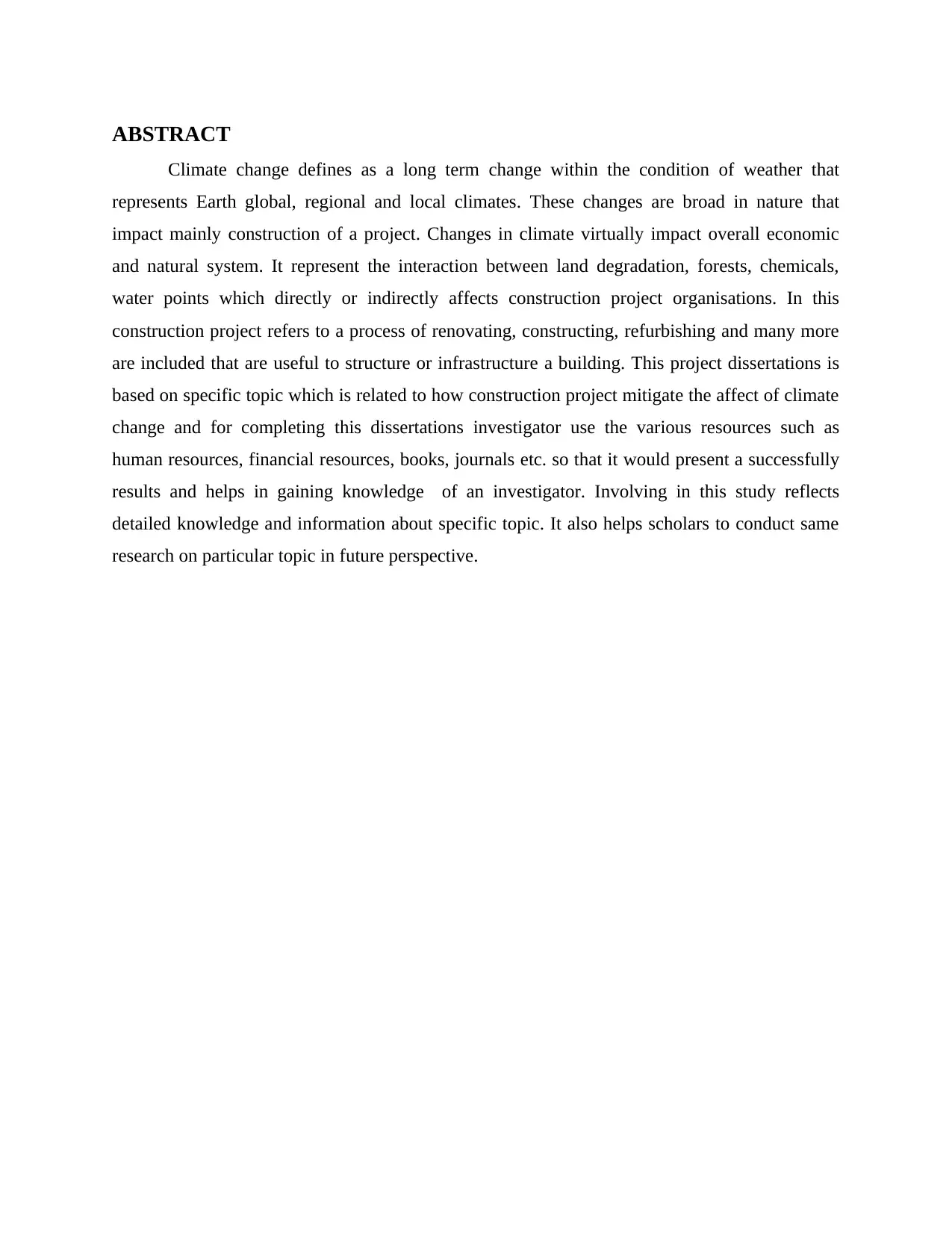
ABSTRACT
Climate change defines as a long term change within the condition of weather that
represents Earth global, regional and local climates. These changes are broad in nature that
impact mainly construction of a project. Changes in climate virtually impact overall economic
and natural system. It represent the interaction between land degradation, forests, chemicals,
water points which directly or indirectly affects construction project organisations. In this
construction project refers to a process of renovating, constructing, refurbishing and many more
are included that are useful to structure or infrastructure a building. This project dissertations is
based on specific topic which is related to how construction project mitigate the affect of climate
change and for completing this dissertations investigator use the various resources such as
human resources, financial resources, books, journals etc. so that it would present a successfully
results and helps in gaining knowledge of an investigator. Involving in this study reflects
detailed knowledge and information about specific topic. It also helps scholars to conduct same
research on particular topic in future perspective.
Climate change defines as a long term change within the condition of weather that
represents Earth global, regional and local climates. These changes are broad in nature that
impact mainly construction of a project. Changes in climate virtually impact overall economic
and natural system. It represent the interaction between land degradation, forests, chemicals,
water points which directly or indirectly affects construction project organisations. In this
construction project refers to a process of renovating, constructing, refurbishing and many more
are included that are useful to structure or infrastructure a building. This project dissertations is
based on specific topic which is related to how construction project mitigate the affect of climate
change and for completing this dissertations investigator use the various resources such as
human resources, financial resources, books, journals etc. so that it would present a successfully
results and helps in gaining knowledge of an investigator. Involving in this study reflects
detailed knowledge and information about specific topic. It also helps scholars to conduct same
research on particular topic in future perspective.
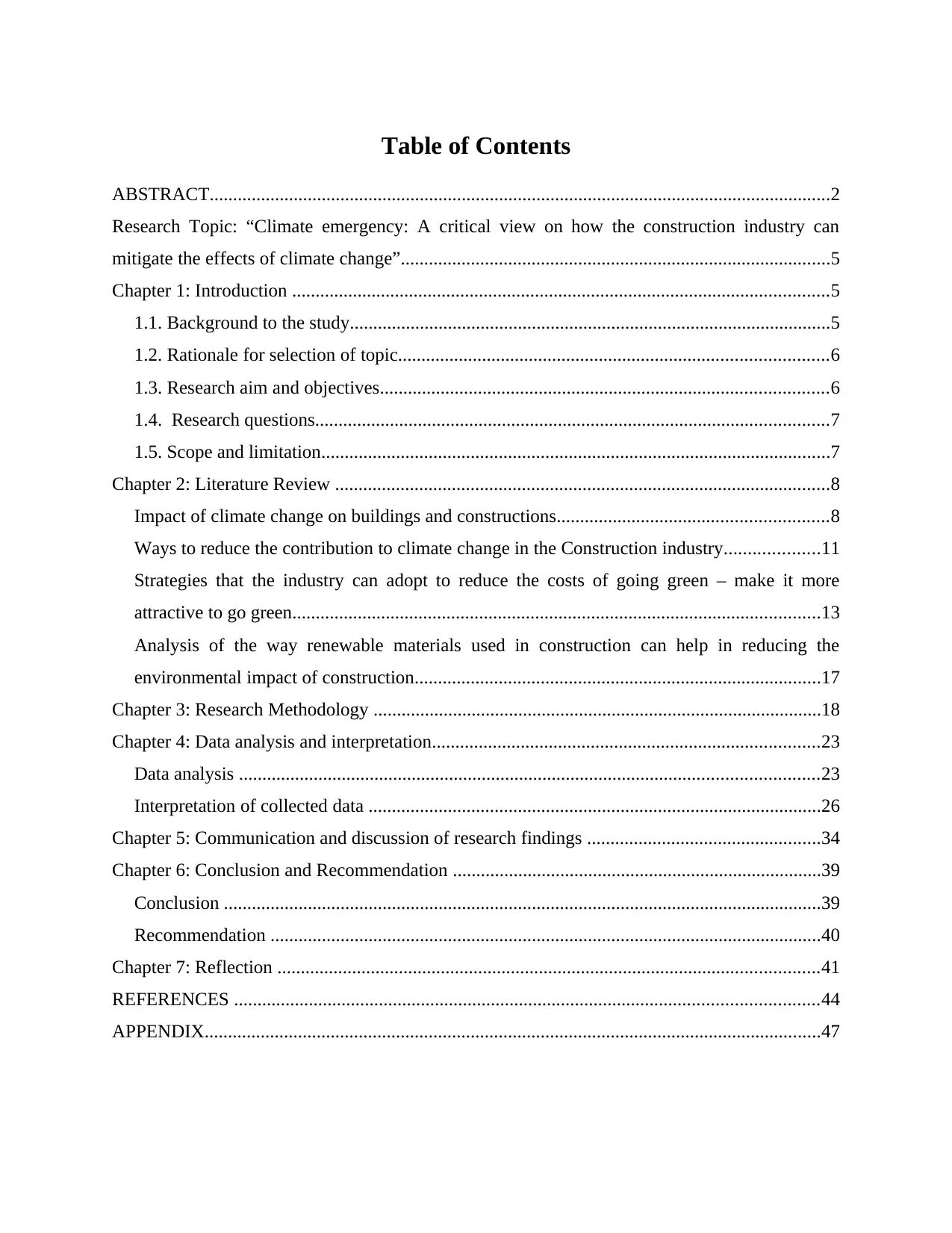
Table of Contents
ABSTRACT.....................................................................................................................................2
Research Topic: “Climate emergency: A critical view on how the construction industry can
mitigate the effects of climate change”............................................................................................5
Chapter 1: Introduction ...................................................................................................................5
1.1. Background to the study.......................................................................................................5
1.2. Rationale for selection of topic............................................................................................6
1.3. Research aim and objectives................................................................................................6
1.4. Research questions..............................................................................................................7
1.5. Scope and limitation.............................................................................................................7
Chapter 2: Literature Review ..........................................................................................................8
Impact of climate change on buildings and constructions..........................................................8
Ways to reduce the contribution to climate change in the Construction industry....................11
Strategies that the industry can adopt to reduce the costs of going green – make it more
attractive to go green.................................................................................................................13
Analysis of the way renewable materials used in construction can help in reducing the
environmental impact of construction.......................................................................................17
Chapter 3: Research Methodology ................................................................................................18
Chapter 4: Data analysis and interpretation...................................................................................23
Data analysis ............................................................................................................................23
Interpretation of collected data .................................................................................................26
Chapter 5: Communication and discussion of research findings ..................................................34
Chapter 6: Conclusion and Recommendation ...............................................................................39
Conclusion ................................................................................................................................39
Recommendation ......................................................................................................................40
Chapter 7: Reflection ....................................................................................................................41
REFERENCES .............................................................................................................................44
APPENDIX....................................................................................................................................47
ABSTRACT.....................................................................................................................................2
Research Topic: “Climate emergency: A critical view on how the construction industry can
mitigate the effects of climate change”............................................................................................5
Chapter 1: Introduction ...................................................................................................................5
1.1. Background to the study.......................................................................................................5
1.2. Rationale for selection of topic............................................................................................6
1.3. Research aim and objectives................................................................................................6
1.4. Research questions..............................................................................................................7
1.5. Scope and limitation.............................................................................................................7
Chapter 2: Literature Review ..........................................................................................................8
Impact of climate change on buildings and constructions..........................................................8
Ways to reduce the contribution to climate change in the Construction industry....................11
Strategies that the industry can adopt to reduce the costs of going green – make it more
attractive to go green.................................................................................................................13
Analysis of the way renewable materials used in construction can help in reducing the
environmental impact of construction.......................................................................................17
Chapter 3: Research Methodology ................................................................................................18
Chapter 4: Data analysis and interpretation...................................................................................23
Data analysis ............................................................................................................................23
Interpretation of collected data .................................................................................................26
Chapter 5: Communication and discussion of research findings ..................................................34
Chapter 6: Conclusion and Recommendation ...............................................................................39
Conclusion ................................................................................................................................39
Recommendation ......................................................................................................................40
Chapter 7: Reflection ....................................................................................................................41
REFERENCES .............................................................................................................................44
APPENDIX....................................................................................................................................47
⊘ This is a preview!⊘
Do you want full access?
Subscribe today to unlock all pages.

Trusted by 1+ million students worldwide

Paraphrase This Document
Need a fresh take? Get an instant paraphrase of this document with our AI Paraphraser
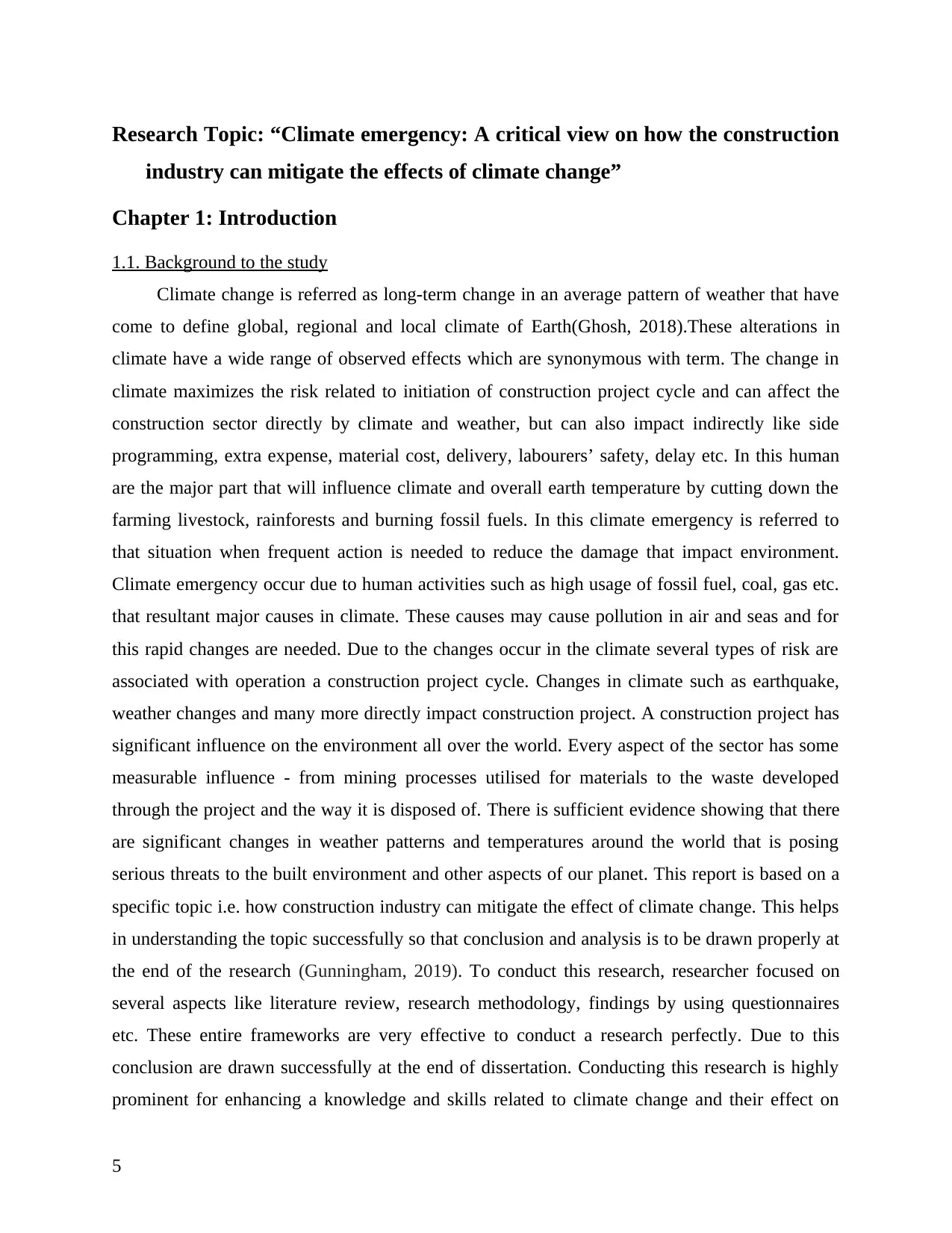
Research Topic: “Climate emergency: A critical view on how the construction
industry can mitigate the effects of climate change”
Chapter 1: Introduction
1.1. Background to the study
Climate change is referred as long-term change in an average pattern of weather that have
come to define global, regional and local climate of Earth(Ghosh, 2018).These alterations in
climate have a wide range of observed effects which are synonymous with term. The change in
climate maximizes the risk related to initiation of construction project cycle and can affect the
construction sector directly by climate and weather, but can also impact indirectly like side
programming, extra expense, material cost, delivery, labourers’ safety, delay etc. In this human
are the major part that will influence climate and overall earth temperature by cutting down the
farming livestock, rainforests and burning fossil fuels. In this climate emergency is referred to
that situation when frequent action is needed to reduce the damage that impact environment.
Climate emergency occur due to human activities such as high usage of fossil fuel, coal, gas etc.
that resultant major causes in climate. These causes may cause pollution in air and seas and for
this rapid changes are needed. Due to the changes occur in the climate several types of risk are
associated with operation a construction project cycle. Changes in climate such as earthquake,
weather changes and many more directly impact construction project. A construction project has
significant influence on the environment all over the world. Every aspect of the sector has some
measurable influence - from mining processes utilised for materials to the waste developed
through the project and the way it is disposed of. There is sufficient evidence showing that there
are significant changes in weather patterns and temperatures around the world that is posing
serious threats to the built environment and other aspects of our planet. This report is based on a
specific topic i.e. how construction industry can mitigate the effect of climate change. This helps
in understanding the topic successfully so that conclusion and analysis is to be drawn properly at
the end of the research (Gunningham, 2019). To conduct this research, researcher focused on
several aspects like literature review, research methodology, findings by using questionnaires
etc. These entire frameworks are very effective to conduct a research perfectly. Due to this
conclusion are drawn successfully at the end of dissertation. Conducting this research is highly
prominent for enhancing a knowledge and skills related to climate change and their effect on
5
industry can mitigate the effects of climate change”
Chapter 1: Introduction
1.1. Background to the study
Climate change is referred as long-term change in an average pattern of weather that have
come to define global, regional and local climate of Earth(Ghosh, 2018).These alterations in
climate have a wide range of observed effects which are synonymous with term. The change in
climate maximizes the risk related to initiation of construction project cycle and can affect the
construction sector directly by climate and weather, but can also impact indirectly like side
programming, extra expense, material cost, delivery, labourers’ safety, delay etc. In this human
are the major part that will influence climate and overall earth temperature by cutting down the
farming livestock, rainforests and burning fossil fuels. In this climate emergency is referred to
that situation when frequent action is needed to reduce the damage that impact environment.
Climate emergency occur due to human activities such as high usage of fossil fuel, coal, gas etc.
that resultant major causes in climate. These causes may cause pollution in air and seas and for
this rapid changes are needed. Due to the changes occur in the climate several types of risk are
associated with operation a construction project cycle. Changes in climate such as earthquake,
weather changes and many more directly impact construction project. A construction project has
significant influence on the environment all over the world. Every aspect of the sector has some
measurable influence - from mining processes utilised for materials to the waste developed
through the project and the way it is disposed of. There is sufficient evidence showing that there
are significant changes in weather patterns and temperatures around the world that is posing
serious threats to the built environment and other aspects of our planet. This report is based on a
specific topic i.e. how construction industry can mitigate the effect of climate change. This helps
in understanding the topic successfully so that conclusion and analysis is to be drawn properly at
the end of the research (Gunningham, 2019). To conduct this research, researcher focused on
several aspects like literature review, research methodology, findings by using questionnaires
etc. These entire frameworks are very effective to conduct a research perfectly. Due to this
conclusion are drawn successfully at the end of dissertation. Conducting this research is highly
prominent for enhancing a knowledge and skills related to climate change and their effect on
5
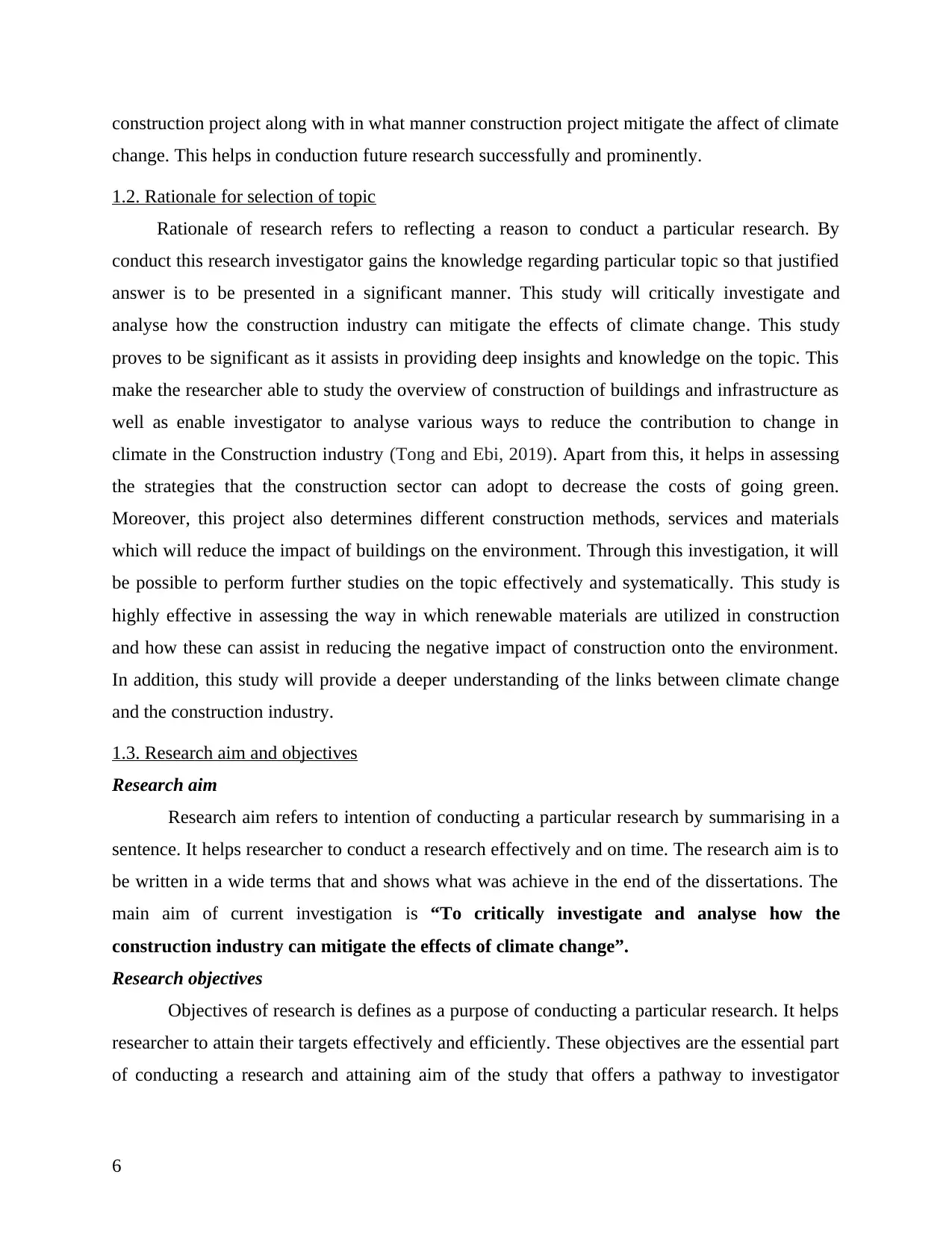
construction project along with in what manner construction project mitigate the affect of climate
change. This helps in conduction future research successfully and prominently.
1.2. Rationale for selection of topic
Rationale of research refers to reflecting a reason to conduct a particular research. By
conduct this research investigator gains the knowledge regarding particular topic so that justified
answer is to be presented in a significant manner. This study will critically investigate and
analyse how the construction industry can mitigate the effects of climate change. This study
proves to be significant as it assists in providing deep insights and knowledge on the topic. This
make the researcher able to study the overview of construction of buildings and infrastructure as
well as enable investigator to analyse various ways to reduce the contribution to change in
climate in the Construction industry (Tong and Ebi, 2019). Apart from this, it helps in assessing
the strategies that the construction sector can adopt to decrease the costs of going green.
Moreover, this project also determines different construction methods, services and materials
which will reduce the impact of buildings on the environment. Through this investigation, it will
be possible to perform further studies on the topic effectively and systematically. This study is
highly effective in assessing the way in which renewable materials are utilized in construction
and how these can assist in reducing the negative impact of construction onto the environment.
In addition, this study will provide a deeper understanding of the links between climate change
and the construction industry.
1.3. Research aim and objectives
Research aim
Research aim refers to intention of conducting a particular research by summarising in a
sentence. It helps researcher to conduct a research effectively and on time. The research aim is to
be written in a wide terms that and shows what was achieve in the end of the dissertations. The
main aim of current investigation is “To critically investigate and analyse how the
construction industry can mitigate the effects of climate change”.
Research objectives
Objectives of research is defines as a purpose of conducting a particular research. It helps
researcher to attain their targets effectively and efficiently. These objectives are the essential part
of conducting a research and attaining aim of the study that offers a pathway to investigator
6
change. This helps in conduction future research successfully and prominently.
1.2. Rationale for selection of topic
Rationale of research refers to reflecting a reason to conduct a particular research. By
conduct this research investigator gains the knowledge regarding particular topic so that justified
answer is to be presented in a significant manner. This study will critically investigate and
analyse how the construction industry can mitigate the effects of climate change. This study
proves to be significant as it assists in providing deep insights and knowledge on the topic. This
make the researcher able to study the overview of construction of buildings and infrastructure as
well as enable investigator to analyse various ways to reduce the contribution to change in
climate in the Construction industry (Tong and Ebi, 2019). Apart from this, it helps in assessing
the strategies that the construction sector can adopt to decrease the costs of going green.
Moreover, this project also determines different construction methods, services and materials
which will reduce the impact of buildings on the environment. Through this investigation, it will
be possible to perform further studies on the topic effectively and systematically. This study is
highly effective in assessing the way in which renewable materials are utilized in construction
and how these can assist in reducing the negative impact of construction onto the environment.
In addition, this study will provide a deeper understanding of the links between climate change
and the construction industry.
1.3. Research aim and objectives
Research aim
Research aim refers to intention of conducting a particular research by summarising in a
sentence. It helps researcher to conduct a research effectively and on time. The research aim is to
be written in a wide terms that and shows what was achieve in the end of the dissertations. The
main aim of current investigation is “To critically investigate and analyse how the
construction industry can mitigate the effects of climate change”.
Research objectives
Objectives of research is defines as a purpose of conducting a particular research. It helps
researcher to attain their targets effectively and efficiently. These objectives are the essential part
of conducting a research and attaining aim of the study that offers a pathway to investigator
6
⊘ This is a preview!⊘
Do you want full access?
Subscribe today to unlock all pages.

Trusted by 1+ million students worldwide
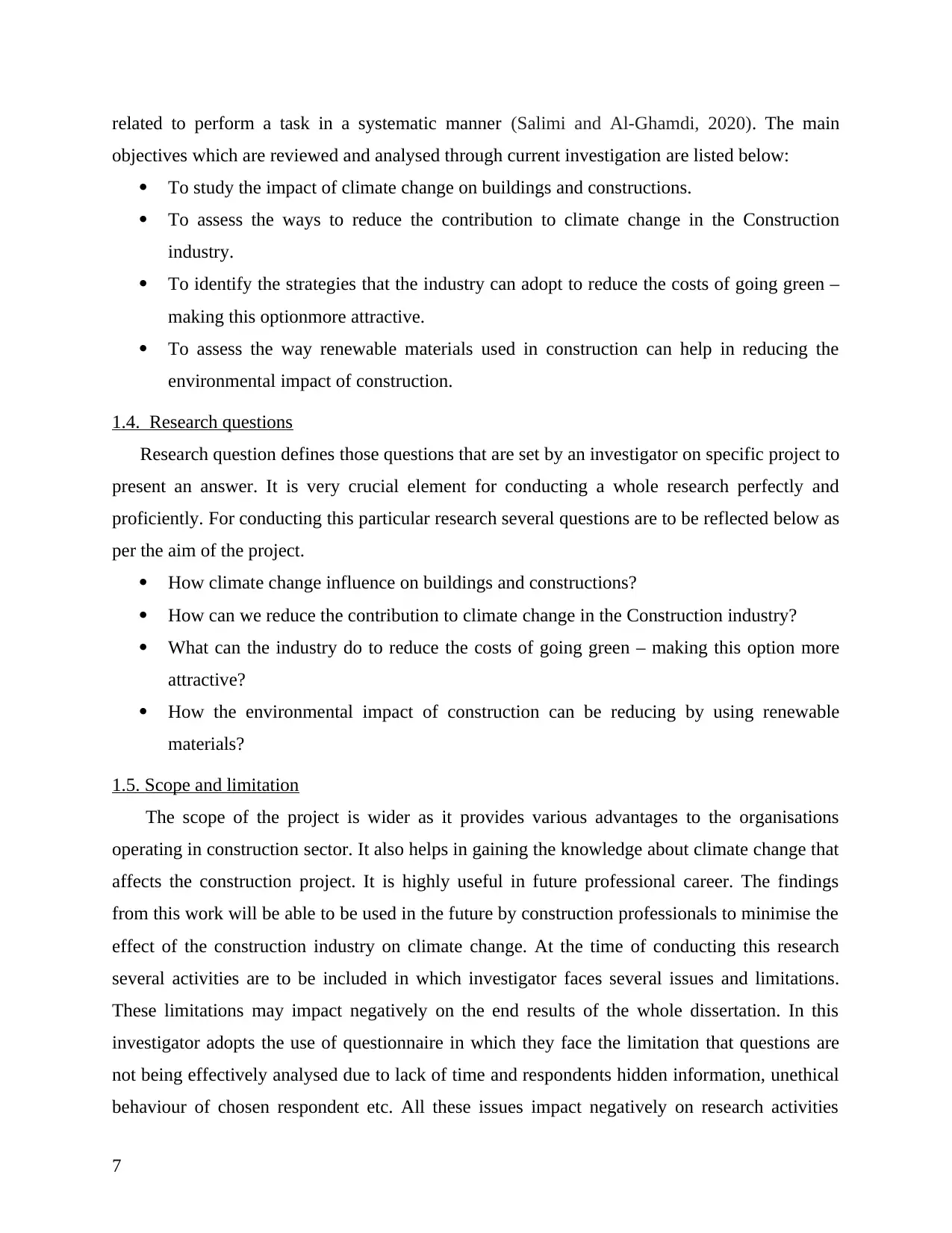
related to perform a task in a systematic manner (Salimi and Al-Ghamdi, 2020). The main
objectives which are reviewed and analysed through current investigation are listed below:
To study the impact of climate change on buildings and constructions.
To assess the ways to reduce the contribution to climate change in the Construction
industry.
To identify the strategies that the industry can adopt to reduce the costs of going green –
making this optionmore attractive.
To assess the way renewable materials used in construction can help in reducing the
environmental impact of construction.
1.4. Research questions
Research question defines those questions that are set by an investigator on specific project to
present an answer. It is very crucial element for conducting a whole research perfectly and
proficiently. For conducting this particular research several questions are to be reflected below as
per the aim of the project.
How climate change influence on buildings and constructions?
How can we reduce the contribution to climate change in the Construction industry?
What can the industry do to reduce the costs of going green – making this option more
attractive?
How the environmental impact of construction can be reducing by using renewable
materials?
1.5. Scope and limitation
The scope of the project is wider as it provides various advantages to the organisations
operating in construction sector. It also helps in gaining the knowledge about climate change that
affects the construction project. It is highly useful in future professional career. The findings
from this work will be able to be used in the future by construction professionals to minimise the
effect of the construction industry on climate change. At the time of conducting this research
several activities are to be included in which investigator faces several issues and limitations.
These limitations may impact negatively on the end results of the whole dissertation. In this
investigator adopts the use of questionnaire in which they face the limitation that questions are
not being effectively analysed due to lack of time and respondents hidden information, unethical
behaviour of chosen respondent etc. All these issues impact negatively on research activities
7
objectives which are reviewed and analysed through current investigation are listed below:
To study the impact of climate change on buildings and constructions.
To assess the ways to reduce the contribution to climate change in the Construction
industry.
To identify the strategies that the industry can adopt to reduce the costs of going green –
making this optionmore attractive.
To assess the way renewable materials used in construction can help in reducing the
environmental impact of construction.
1.4. Research questions
Research question defines those questions that are set by an investigator on specific project to
present an answer. It is very crucial element for conducting a whole research perfectly and
proficiently. For conducting this particular research several questions are to be reflected below as
per the aim of the project.
How climate change influence on buildings and constructions?
How can we reduce the contribution to climate change in the Construction industry?
What can the industry do to reduce the costs of going green – making this option more
attractive?
How the environmental impact of construction can be reducing by using renewable
materials?
1.5. Scope and limitation
The scope of the project is wider as it provides various advantages to the organisations
operating in construction sector. It also helps in gaining the knowledge about climate change that
affects the construction project. It is highly useful in future professional career. The findings
from this work will be able to be used in the future by construction professionals to minimise the
effect of the construction industry on climate change. At the time of conducting this research
several activities are to be included in which investigator faces several issues and limitations.
These limitations may impact negatively on the end results of the whole dissertation. In this
investigator adopts the use of questionnaire in which they face the limitation that questions are
not being effectively analysed due to lack of time and respondents hidden information, unethical
behaviour of chosen respondent etc. All these issues impact negatively on research activities
7
Paraphrase This Document
Need a fresh take? Get an instant paraphrase of this document with our AI Paraphraser
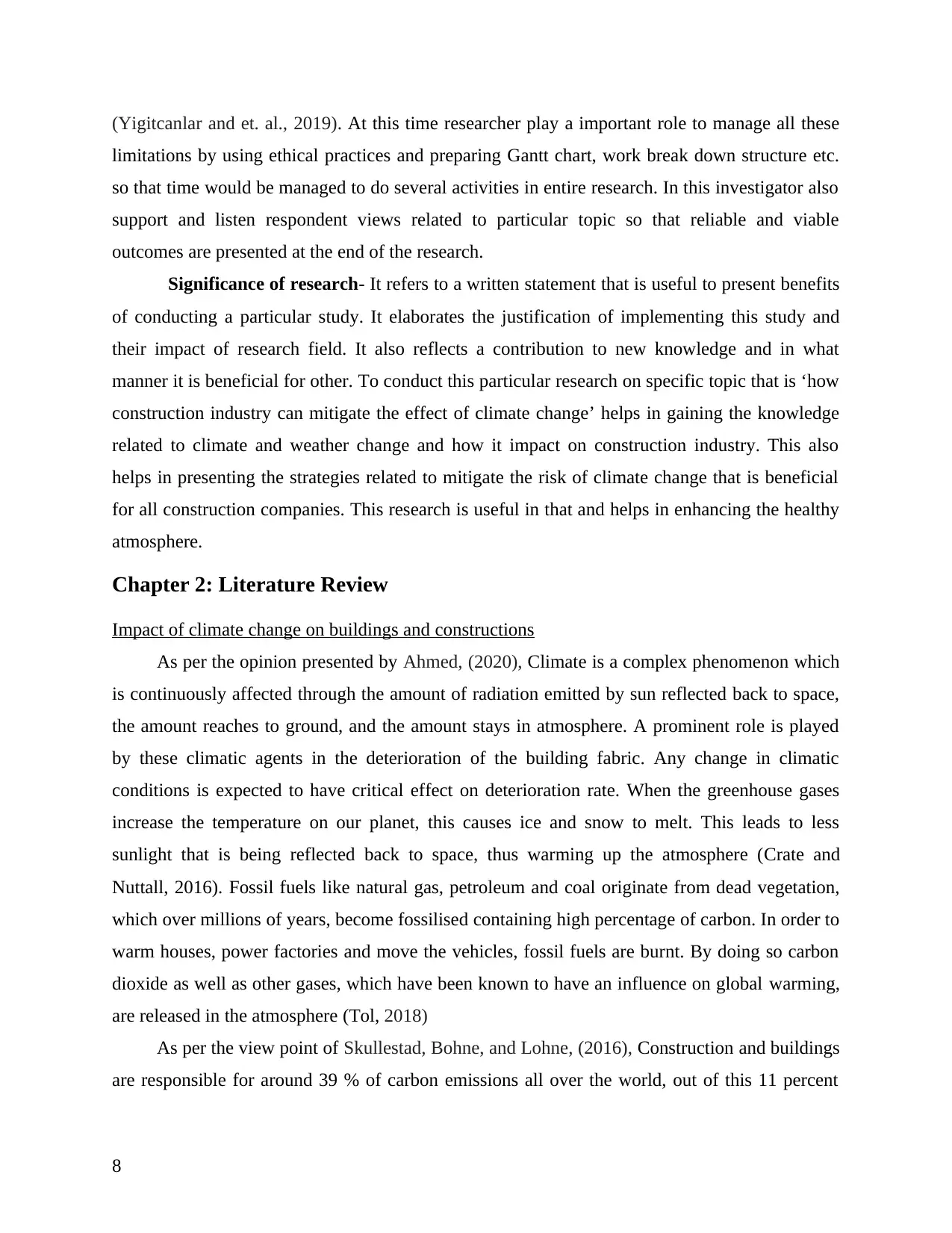
(Yigitcanlar and et. al., 2019). At this time researcher play a important role to manage all these
limitations by using ethical practices and preparing Gantt chart, work break down structure etc.
so that time would be managed to do several activities in entire research. In this investigator also
support and listen respondent views related to particular topic so that reliable and viable
outcomes are presented at the end of the research.
Significance of research- It refers to a written statement that is useful to present benefits
of conducting a particular study. It elaborates the justification of implementing this study and
their impact of research field. It also reflects a contribution to new knowledge and in what
manner it is beneficial for other. To conduct this particular research on specific topic that is ‘how
construction industry can mitigate the effect of climate change’ helps in gaining the knowledge
related to climate and weather change and how it impact on construction industry. This also
helps in presenting the strategies related to mitigate the risk of climate change that is beneficial
for all construction companies. This research is useful in that and helps in enhancing the healthy
atmosphere.
Chapter 2: Literature Review
Impact of climate change on buildings and constructions
As per the opinion presented by Ahmed, (2020), Climate is a complex phenomenon which
is continuously affected through the amount of radiation emitted by sun reflected back to space,
the amount reaches to ground, and the amount stays in atmosphere. A prominent role is played
by these climatic agents in the deterioration of the building fabric. Any change in climatic
conditions is expected to have critical effect on deterioration rate. When the greenhouse gases
increase the temperature on our planet, this causes ice and snow to melt. This leads to less
sunlight that is being reflected back to space, thus warming up the atmosphere (Crate and
Nuttall, 2016). Fossil fuels like natural gas, petroleum and coal originate from dead vegetation,
which over millions of years, become fossilised containing high percentage of carbon. In order to
warm houses, power factories and move the vehicles, fossil fuels are burnt. By doing so carbon
dioxide as well as other gases, which have been known to have an influence on global warming,
are released in the atmosphere (Tol, 2018)
As per the view point of Skullestad, Bohne, and Lohne, (2016), Construction and buildings
are responsible for around 39 % of carbon emissions all over the world, out of this 11 percent
8
limitations by using ethical practices and preparing Gantt chart, work break down structure etc.
so that time would be managed to do several activities in entire research. In this investigator also
support and listen respondent views related to particular topic so that reliable and viable
outcomes are presented at the end of the research.
Significance of research- It refers to a written statement that is useful to present benefits
of conducting a particular study. It elaborates the justification of implementing this study and
their impact of research field. It also reflects a contribution to new knowledge and in what
manner it is beneficial for other. To conduct this particular research on specific topic that is ‘how
construction industry can mitigate the effect of climate change’ helps in gaining the knowledge
related to climate and weather change and how it impact on construction industry. This also
helps in presenting the strategies related to mitigate the risk of climate change that is beneficial
for all construction companies. This research is useful in that and helps in enhancing the healthy
atmosphere.
Chapter 2: Literature Review
Impact of climate change on buildings and constructions
As per the opinion presented by Ahmed, (2020), Climate is a complex phenomenon which
is continuously affected through the amount of radiation emitted by sun reflected back to space,
the amount reaches to ground, and the amount stays in atmosphere. A prominent role is played
by these climatic agents in the deterioration of the building fabric. Any change in climatic
conditions is expected to have critical effect on deterioration rate. When the greenhouse gases
increase the temperature on our planet, this causes ice and snow to melt. This leads to less
sunlight that is being reflected back to space, thus warming up the atmosphere (Crate and
Nuttall, 2016). Fossil fuels like natural gas, petroleum and coal originate from dead vegetation,
which over millions of years, become fossilised containing high percentage of carbon. In order to
warm houses, power factories and move the vehicles, fossil fuels are burnt. By doing so carbon
dioxide as well as other gases, which have been known to have an influence on global warming,
are released in the atmosphere (Tol, 2018)
As per the view point of Skullestad, Bohne, and Lohne, (2016), Construction and buildings
are responsible for around 39 % of carbon emissions all over the world, out of this 11 percent
8
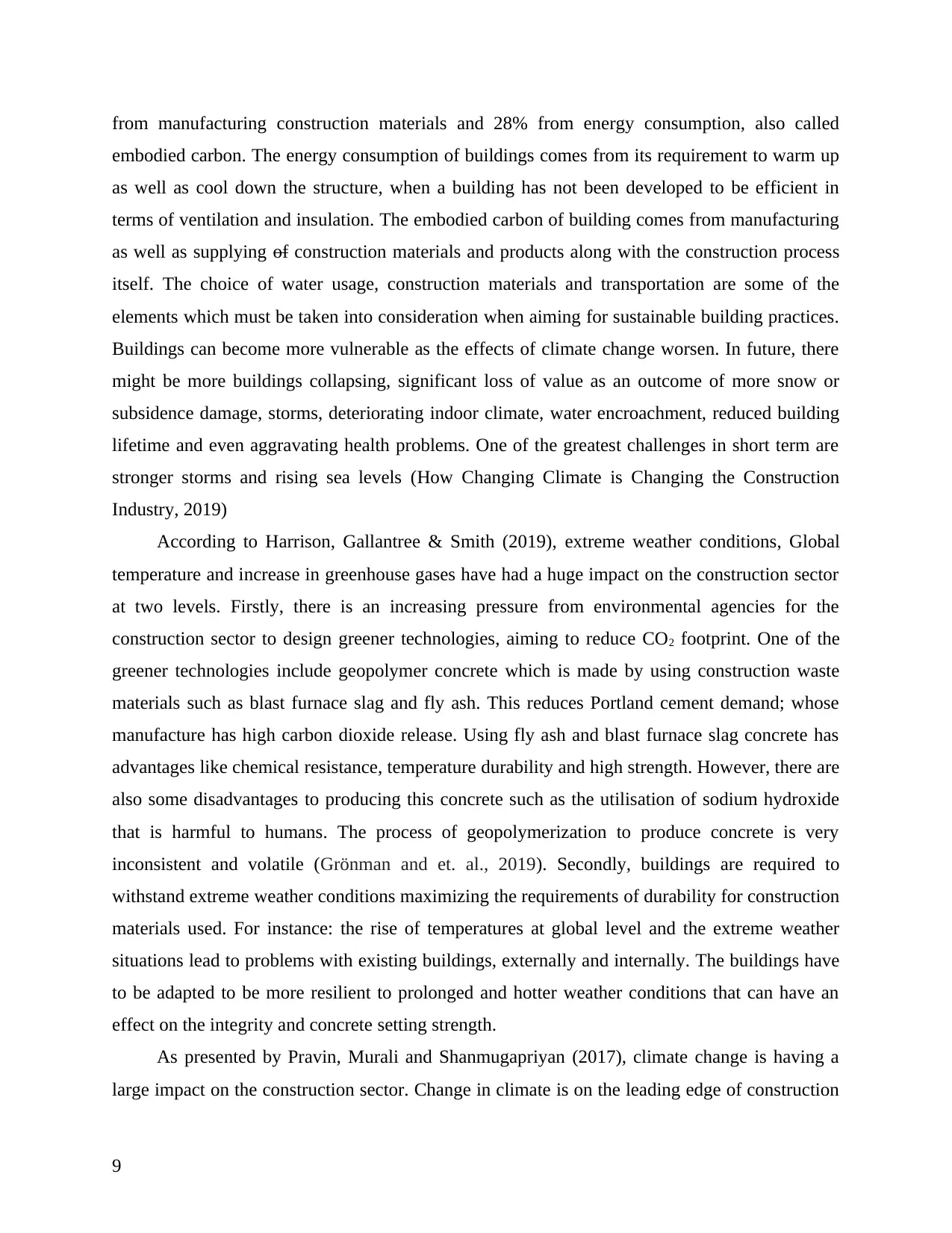
from manufacturing construction materials and 28% from energy consumption, also called
embodied carbon. The energy consumption of buildings comes from its requirement to warm up
as well as cool down the structure, when a building has not been developed to be efficient in
terms of ventilation and insulation. The embodied carbon of building comes from manufacturing
as well as supplying of construction materials and products along with the construction process
itself. The choice of water usage, construction materials and transportation are some of the
elements which must be taken into consideration when aiming for sustainable building practices.
Buildings can become more vulnerable as the effects of climate change worsen. In future, there
might be more buildings collapsing, significant loss of value as an outcome of more snow or
subsidence damage, storms, deteriorating indoor climate, water encroachment, reduced building
lifetime and even aggravating health problems. One of the greatest challenges in short term are
stronger storms and rising sea levels (How Changing Climate is Changing the Construction
Industry, 2019)
According to Harrison, Gallantree & Smith (2019), extreme weather conditions, Global
temperature and increase in greenhouse gases have had a huge impact on the construction sector
at two levels. Firstly, there is an increasing pressure from environmental agencies for the
construction sector to design greener technologies, aiming to reduce CO2 footprint. One of the
greener technologies include geopolymer concrete which is made by using construction waste
materials such as blast furnace slag and fly ash. This reduces Portland cement demand; whose
manufacture has high carbon dioxide release. Using fly ash and blast furnace slag concrete has
advantages like chemical resistance, temperature durability and high strength. However, there are
also some disadvantages to producing this concrete such as the utilisation of sodium hydroxide
that is harmful to humans. The process of geopolymerization to produce concrete is very
inconsistent and volatile (Grönman and et. al., 2019). Secondly, buildings are required to
withstand extreme weather conditions maximizing the requirements of durability for construction
materials used. For instance: the rise of temperatures at global level and the extreme weather
situations lead to problems with existing buildings, externally and internally. The buildings have
to be adapted to be more resilient to prolonged and hotter weather conditions that can have an
effect on the integrity and concrete setting strength.
As presented by Pravin, Murali and Shanmugapriyan (2017), climate change is having a
large impact on the construction sector. Change in climate is on the leading edge of construction
9
embodied carbon. The energy consumption of buildings comes from its requirement to warm up
as well as cool down the structure, when a building has not been developed to be efficient in
terms of ventilation and insulation. The embodied carbon of building comes from manufacturing
as well as supplying of construction materials and products along with the construction process
itself. The choice of water usage, construction materials and transportation are some of the
elements which must be taken into consideration when aiming for sustainable building practices.
Buildings can become more vulnerable as the effects of climate change worsen. In future, there
might be more buildings collapsing, significant loss of value as an outcome of more snow or
subsidence damage, storms, deteriorating indoor climate, water encroachment, reduced building
lifetime and even aggravating health problems. One of the greatest challenges in short term are
stronger storms and rising sea levels (How Changing Climate is Changing the Construction
Industry, 2019)
According to Harrison, Gallantree & Smith (2019), extreme weather conditions, Global
temperature and increase in greenhouse gases have had a huge impact on the construction sector
at two levels. Firstly, there is an increasing pressure from environmental agencies for the
construction sector to design greener technologies, aiming to reduce CO2 footprint. One of the
greener technologies include geopolymer concrete which is made by using construction waste
materials such as blast furnace slag and fly ash. This reduces Portland cement demand; whose
manufacture has high carbon dioxide release. Using fly ash and blast furnace slag concrete has
advantages like chemical resistance, temperature durability and high strength. However, there are
also some disadvantages to producing this concrete such as the utilisation of sodium hydroxide
that is harmful to humans. The process of geopolymerization to produce concrete is very
inconsistent and volatile (Grönman and et. al., 2019). Secondly, buildings are required to
withstand extreme weather conditions maximizing the requirements of durability for construction
materials used. For instance: the rise of temperatures at global level and the extreme weather
situations lead to problems with existing buildings, externally and internally. The buildings have
to be adapted to be more resilient to prolonged and hotter weather conditions that can have an
effect on the integrity and concrete setting strength.
As presented by Pravin, Murali and Shanmugapriyan (2017), climate change is having a
large impact on the construction sector. Change in climate is on the leading edge of construction
9
⊘ This is a preview!⊘
Do you want full access?
Subscribe today to unlock all pages.

Trusted by 1+ million students worldwide
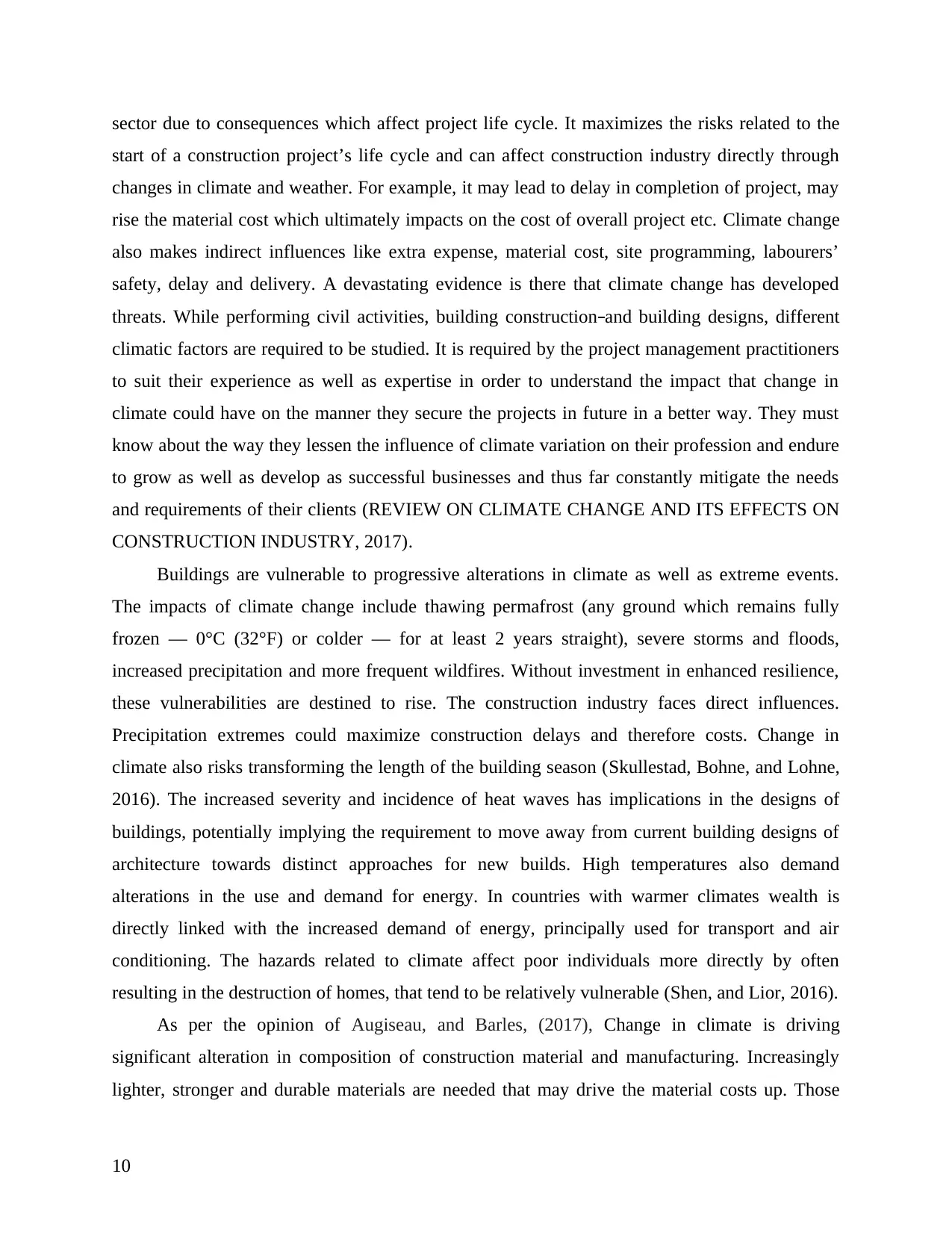
sector due to consequences which affect project life cycle. It maximizes the risks related to the
start of a construction project’s life cycle and can affect construction industry directly through
changes in climate and weather. For example, it may lead to delay in completion of project, may
rise the material cost which ultimately impacts on the cost of overall project etc. Climate change
also makes indirect influences like extra expense, material cost, site programming, labourers’
safety, delay and delivery. A devastating evidence is there that climate change has developed
threats. While performing civil activities, building construction and building designs, different
climatic factors are required to be studied. It is required by the project management practitioners
to suit their experience as well as expertise in order to understand the impact that change in
climate could have on the manner they secure the projects in future in a better way. They must
know about the way they lessen the influence of climate variation on their profession and endure
to grow as well as develop as successful businesses and thus far constantly mitigate the needs
and requirements of their clients (REVIEW ON CLIMATE CHANGE AND ITS EFFECTS ON
CONSTRUCTION INDUSTRY, 2017).
Buildings are vulnerable to progressive alterations in climate as well as extreme events.
The impacts of climate change include thawing permafrost (any ground which remains fully
frozen — 0°C (32°F) or colder — for at least 2 years straight), severe storms and floods,
increased precipitation and more frequent wildfires. Without investment in enhanced resilience,
these vulnerabilities are destined to rise. The construction industry faces direct influences.
Precipitation extremes could maximize construction delays and therefore costs. Change in
climate also risks transforming the length of the building season (Skullestad, Bohne, and Lohne,
2016). The increased severity and incidence of heat waves has implications in the designs of
buildings, potentially implying the requirement to move away from current building designs of
architecture towards distinct approaches for new builds. High temperatures also demand
alterations in the use and demand for energy. In countries with warmer climates wealth is
directly linked with the increased demand of energy, principally used for transport and air
conditioning. The hazards related to climate affect poor individuals more directly by often
resulting in the destruction of homes, that tend to be relatively vulnerable (Shen, and Lior, 2016).
As per the opinion of Augiseau, and Barles, (2017), Change in climate is driving
significant alteration in composition of construction material and manufacturing. Increasingly
lighter, stronger and durable materials are needed that may drive the material costs up. Those
10
start of a construction project’s life cycle and can affect construction industry directly through
changes in climate and weather. For example, it may lead to delay in completion of project, may
rise the material cost which ultimately impacts on the cost of overall project etc. Climate change
also makes indirect influences like extra expense, material cost, site programming, labourers’
safety, delay and delivery. A devastating evidence is there that climate change has developed
threats. While performing civil activities, building construction and building designs, different
climatic factors are required to be studied. It is required by the project management practitioners
to suit their experience as well as expertise in order to understand the impact that change in
climate could have on the manner they secure the projects in future in a better way. They must
know about the way they lessen the influence of climate variation on their profession and endure
to grow as well as develop as successful businesses and thus far constantly mitigate the needs
and requirements of their clients (REVIEW ON CLIMATE CHANGE AND ITS EFFECTS ON
CONSTRUCTION INDUSTRY, 2017).
Buildings are vulnerable to progressive alterations in climate as well as extreme events.
The impacts of climate change include thawing permafrost (any ground which remains fully
frozen — 0°C (32°F) or colder — for at least 2 years straight), severe storms and floods,
increased precipitation and more frequent wildfires. Without investment in enhanced resilience,
these vulnerabilities are destined to rise. The construction industry faces direct influences.
Precipitation extremes could maximize construction delays and therefore costs. Change in
climate also risks transforming the length of the building season (Skullestad, Bohne, and Lohne,
2016). The increased severity and incidence of heat waves has implications in the designs of
buildings, potentially implying the requirement to move away from current building designs of
architecture towards distinct approaches for new builds. High temperatures also demand
alterations in the use and demand for energy. In countries with warmer climates wealth is
directly linked with the increased demand of energy, principally used for transport and air
conditioning. The hazards related to climate affect poor individuals more directly by often
resulting in the destruction of homes, that tend to be relatively vulnerable (Shen, and Lior, 2016).
As per the opinion of Augiseau, and Barles, (2017), Change in climate is driving
significant alteration in composition of construction material and manufacturing. Increasingly
lighter, stronger and durable materials are needed that may drive the material costs up. Those
10
Paraphrase This Document
Need a fresh take? Get an instant paraphrase of this document with our AI Paraphraser
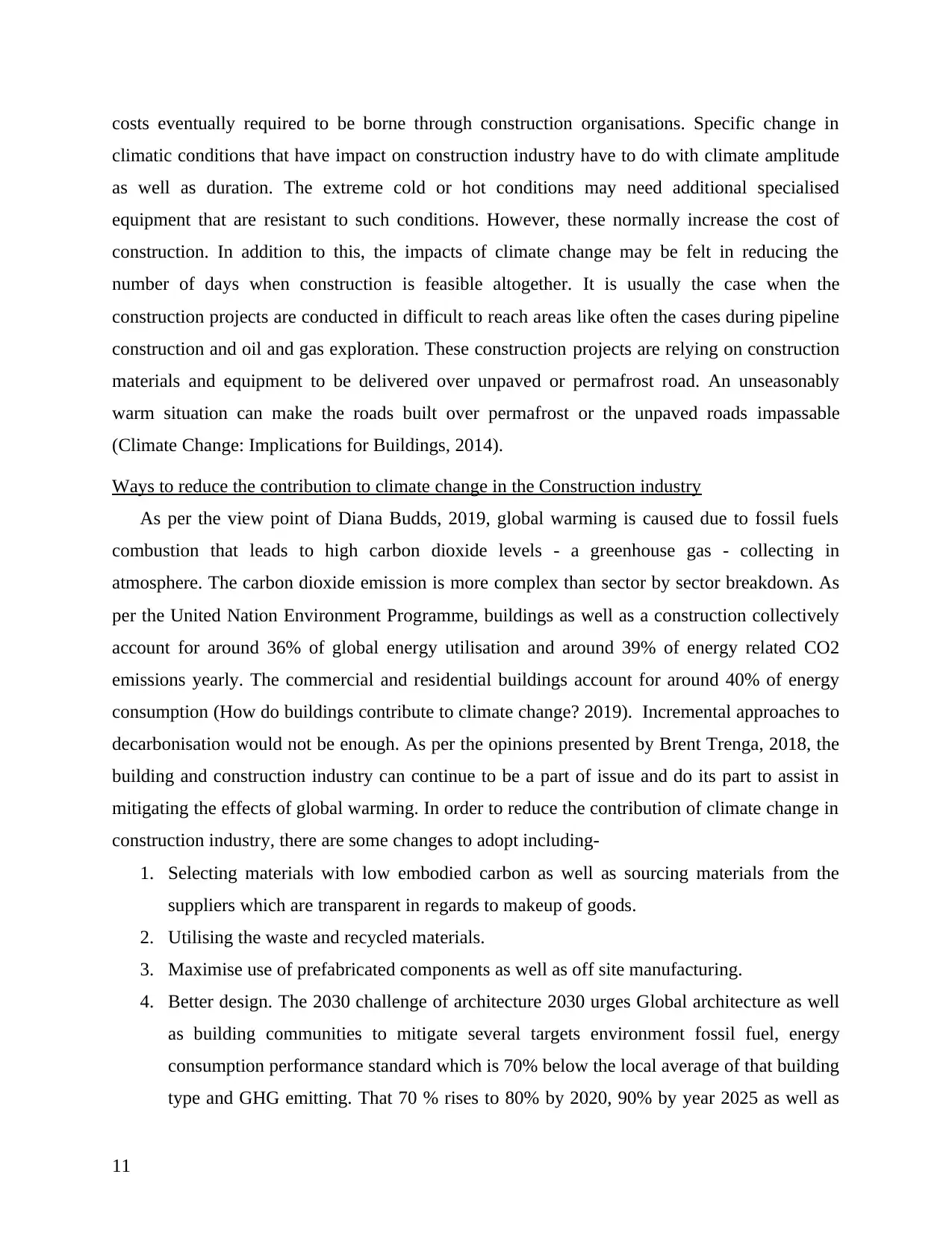
costs eventually required to be borne through construction organisations. Specific change in
climatic conditions that have impact on construction industry have to do with climate amplitude
as well as duration. The extreme cold or hot conditions may need additional specialised
equipment that are resistant to such conditions. However, these normally increase the cost of
construction. In addition to this, the impacts of climate change may be felt in reducing the
number of days when construction is feasible altogether. It is usually the case when the
construction projects are conducted in difficult to reach areas like often the cases during pipeline
construction and oil and gas exploration. These construction projects are relying on construction
materials and equipment to be delivered over unpaved or permafrost road. An unseasonably
warm situation can make the roads built over permafrost or the unpaved roads impassable
(Climate Change: Implications for Buildings, 2014).
Ways to reduce the contribution to climate change in the Construction industry
As per the view point of Diana Budds, 2019, global warming is caused due to fossil fuels
combustion that leads to high carbon dioxide levels - a greenhouse gas - collecting in
atmosphere. The carbon dioxide emission is more complex than sector by sector breakdown. As
per the United Nation Environment Programme, buildings as well as a construction collectively
account for around 36% of global energy utilisation and around 39% of energy related CO2
emissions yearly. The commercial and residential buildings account for around 40% of energy
consumption (How do buildings contribute to climate change? 2019). Incremental approaches to
decarbonisation would not be enough. As per the opinions presented by Brent Trenga, 2018, the
building and construction industry can continue to be a part of issue and do its part to assist in
mitigating the effects of global warming. In order to reduce the contribution of climate change in
construction industry, there are some changes to adopt including-
1. Selecting materials with low embodied carbon as well as sourcing materials from the
suppliers which are transparent in regards to makeup of goods.
2. Utilising the waste and recycled materials.
3. Maximise use of prefabricated components as well as off site manufacturing.
4. Better design. The 2030 challenge of architecture 2030 urges Global architecture as well
as building communities to mitigate several targets environment fossil fuel, energy
consumption performance standard which is 70% below the local average of that building
type and GHG emitting. That 70 % rises to 80% by 2020, 90% by year 2025 as well as
11
climatic conditions that have impact on construction industry have to do with climate amplitude
as well as duration. The extreme cold or hot conditions may need additional specialised
equipment that are resistant to such conditions. However, these normally increase the cost of
construction. In addition to this, the impacts of climate change may be felt in reducing the
number of days when construction is feasible altogether. It is usually the case when the
construction projects are conducted in difficult to reach areas like often the cases during pipeline
construction and oil and gas exploration. These construction projects are relying on construction
materials and equipment to be delivered over unpaved or permafrost road. An unseasonably
warm situation can make the roads built over permafrost or the unpaved roads impassable
(Climate Change: Implications for Buildings, 2014).
Ways to reduce the contribution to climate change in the Construction industry
As per the view point of Diana Budds, 2019, global warming is caused due to fossil fuels
combustion that leads to high carbon dioxide levels - a greenhouse gas - collecting in
atmosphere. The carbon dioxide emission is more complex than sector by sector breakdown. As
per the United Nation Environment Programme, buildings as well as a construction collectively
account for around 36% of global energy utilisation and around 39% of energy related CO2
emissions yearly. The commercial and residential buildings account for around 40% of energy
consumption (How do buildings contribute to climate change? 2019). Incremental approaches to
decarbonisation would not be enough. As per the opinions presented by Brent Trenga, 2018, the
building and construction industry can continue to be a part of issue and do its part to assist in
mitigating the effects of global warming. In order to reduce the contribution of climate change in
construction industry, there are some changes to adopt including-
1. Selecting materials with low embodied carbon as well as sourcing materials from the
suppliers which are transparent in regards to makeup of goods.
2. Utilising the waste and recycled materials.
3. Maximise use of prefabricated components as well as off site manufacturing.
4. Better design. The 2030 challenge of architecture 2030 urges Global architecture as well
as building communities to mitigate several targets environment fossil fuel, energy
consumption performance standard which is 70% below the local average of that building
type and GHG emitting. That 70 % rises to 80% by 2020, 90% by year 2025 as well as
11
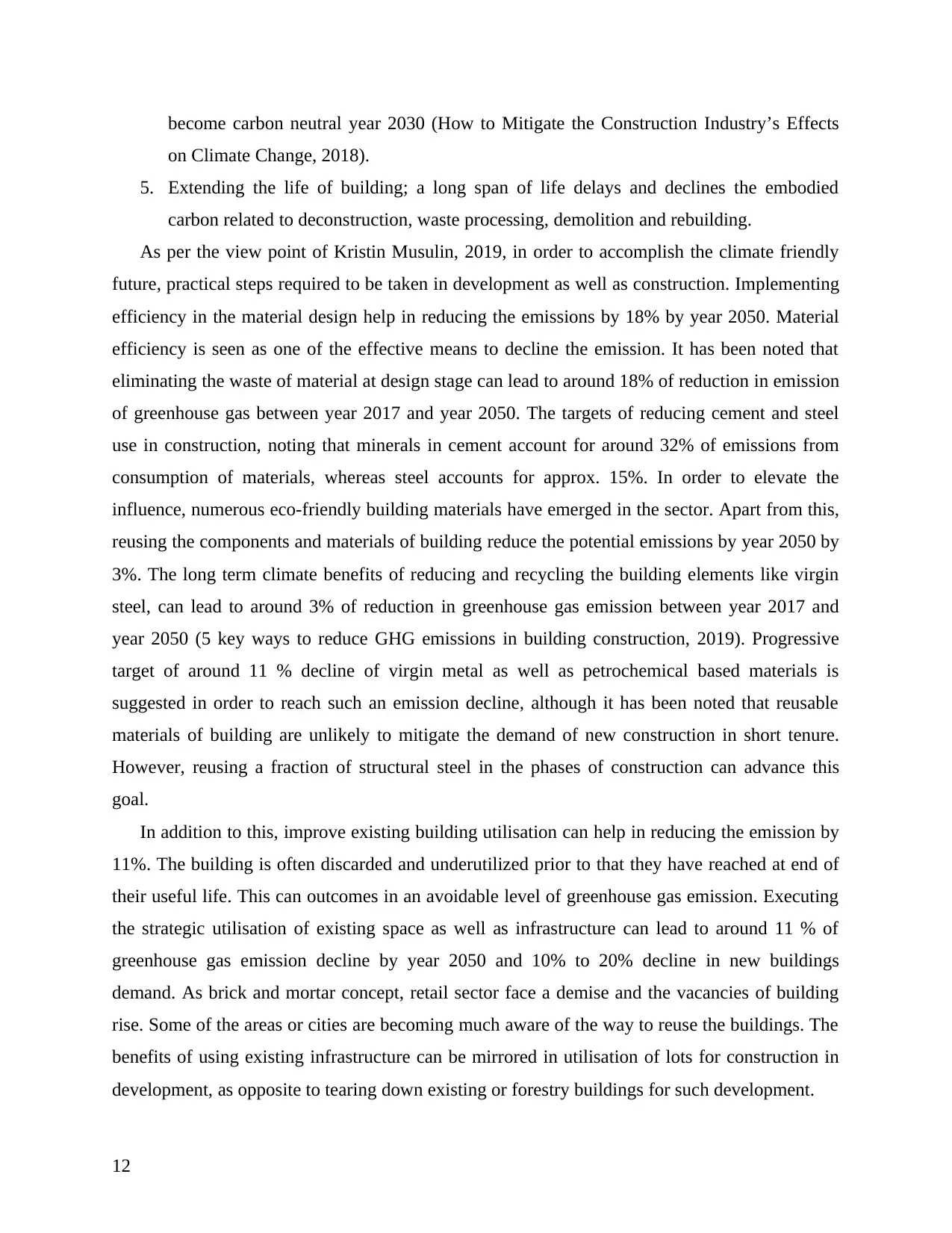
become carbon neutral year 2030 (How to Mitigate the Construction Industry’s Effects
on Climate Change, 2018).
5. Extending the life of building; a long span of life delays and declines the embodied
carbon related to deconstruction, waste processing, demolition and rebuilding.
As per the view point of Kristin Musulin, 2019, in order to accomplish the climate friendly
future, practical steps required to be taken in development as well as construction. Implementing
efficiency in the material design help in reducing the emissions by 18% by year 2050. Material
efficiency is seen as one of the effective means to decline the emission. It has been noted that
eliminating the waste of material at design stage can lead to around 18% of reduction in emission
of greenhouse gas between year 2017 and year 2050. The targets of reducing cement and steel
use in construction, noting that minerals in cement account for around 32% of emissions from
consumption of materials, whereas steel accounts for approx. 15%. In order to elevate the
influence, numerous eco-friendly building materials have emerged in the sector. Apart from this,
reusing the components and materials of building reduce the potential emissions by year 2050 by
3%. The long term climate benefits of reducing and recycling the building elements like virgin
steel, can lead to around 3% of reduction in greenhouse gas emission between year 2017 and
year 2050 (5 key ways to reduce GHG emissions in building construction, 2019). Progressive
target of around 11 % decline of virgin metal as well as petrochemical based materials is
suggested in order to reach such an emission decline, although it has been noted that reusable
materials of building are unlikely to mitigate the demand of new construction in short tenure.
However, reusing a fraction of structural steel in the phases of construction can advance this
goal.
In addition to this, improve existing building utilisation can help in reducing the emission by
11%. The building is often discarded and underutilized prior to that they have reached at end of
their useful life. This can outcomes in an avoidable level of greenhouse gas emission. Executing
the strategic utilisation of existing space as well as infrastructure can lead to around 11 % of
greenhouse gas emission decline by year 2050 and 10% to 20% decline in new buildings
demand. As brick and mortar concept, retail sector face a demise and the vacancies of building
rise. Some of the areas or cities are becoming much aware of the way to reuse the buildings. The
benefits of using existing infrastructure can be mirrored in utilisation of lots for construction in
development, as opposite to tearing down existing or forestry buildings for such development.
12
on Climate Change, 2018).
5. Extending the life of building; a long span of life delays and declines the embodied
carbon related to deconstruction, waste processing, demolition and rebuilding.
As per the view point of Kristin Musulin, 2019, in order to accomplish the climate friendly
future, practical steps required to be taken in development as well as construction. Implementing
efficiency in the material design help in reducing the emissions by 18% by year 2050. Material
efficiency is seen as one of the effective means to decline the emission. It has been noted that
eliminating the waste of material at design stage can lead to around 18% of reduction in emission
of greenhouse gas between year 2017 and year 2050. The targets of reducing cement and steel
use in construction, noting that minerals in cement account for around 32% of emissions from
consumption of materials, whereas steel accounts for approx. 15%. In order to elevate the
influence, numerous eco-friendly building materials have emerged in the sector. Apart from this,
reusing the components and materials of building reduce the potential emissions by year 2050 by
3%. The long term climate benefits of reducing and recycling the building elements like virgin
steel, can lead to around 3% of reduction in greenhouse gas emission between year 2017 and
year 2050 (5 key ways to reduce GHG emissions in building construction, 2019). Progressive
target of around 11 % decline of virgin metal as well as petrochemical based materials is
suggested in order to reach such an emission decline, although it has been noted that reusable
materials of building are unlikely to mitigate the demand of new construction in short tenure.
However, reusing a fraction of structural steel in the phases of construction can advance this
goal.
In addition to this, improve existing building utilisation can help in reducing the emission by
11%. The building is often discarded and underutilized prior to that they have reached at end of
their useful life. This can outcomes in an avoidable level of greenhouse gas emission. Executing
the strategic utilisation of existing space as well as infrastructure can lead to around 11 % of
greenhouse gas emission decline by year 2050 and 10% to 20% decline in new buildings
demand. As brick and mortar concept, retail sector face a demise and the vacancies of building
rise. Some of the areas or cities are becoming much aware of the way to reuse the buildings. The
benefits of using existing infrastructure can be mirrored in utilisation of lots for construction in
development, as opposite to tearing down existing or forestry buildings for such development.
12
⊘ This is a preview!⊘
Do you want full access?
Subscribe today to unlock all pages.

Trusted by 1+ million students worldwide
1 out of 52
Related Documents
Your All-in-One AI-Powered Toolkit for Academic Success.
+13062052269
info@desklib.com
Available 24*7 on WhatsApp / Email
![[object Object]](/_next/static/media/star-bottom.7253800d.svg)
Unlock your academic potential
Copyright © 2020–2025 A2Z Services. All Rights Reserved. Developed and managed by ZUCOL.





